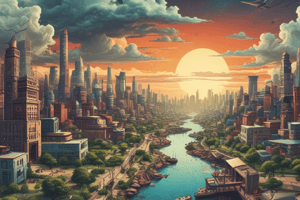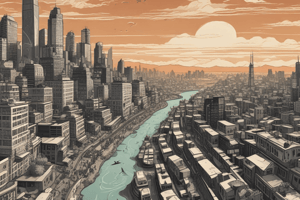Podcast
Questions and Answers
A metropolitan area is best described as:
A metropolitan area is best described as:
- A city plus its surrounding areas that are influenced socially and economically. (correct)
- A city only, without surrounding areas.
- A rural area with a small town center.
- An area with agricultural land and a low population density.
Edge cities are characterized by a declining CBD and serve as mini-downtowns for suburban populations.
Edge cities are characterized by a declining CBD and serve as mini-downtowns for suburban populations.
True (A)
According to the rank-size rule, the fourth largest city in a country is generally about ______ the size of the largest city.
According to the rank-size rule, the fourth largest city in a country is generally about ______ the size of the largest city.
a quarter
Match each city model with its key characteristic:
Match each city model with its key characteristic:
Which of the following is NOT a typical feature of Latin American cities as described by the Griffin-Ford model?
Which of the following is NOT a typical feature of Latin American cities as described by the Griffin-Ford model?
The Gravity Model suggests that interaction is greater between larger and closer places.
The Gravity Model suggests that interaction is greater between larger and closer places.
Which of the following policies aims to limit urban sprawl?
Which of the following policies aims to limit urban sprawl?
Name two of the strengths of Urban Design Initiatives
Name two of the strengths of Urban Design Initiatives
What is gentrification?
What is gentrification?
New Urbanism promotes mixed-use areas combining commercial and residential spaces that are designed to be walkable.
New Urbanism promotes mixed-use areas combining commercial and residential spaces that are designed to be walkable.
The term ______ refers to small communities lying outside the suburbs of a city.
The term ______ refers to small communities lying outside the suburbs of a city.
Define the term 'primate city' and provide a regional example.
Define the term 'primate city' and provide a regional example.
Match each challenge of urban change with its description:
Match each challenge of urban change with its description:
Which of the following best describes 'redlining'?
Which of the following best describes 'redlining'?
Urban areas typically have lower housing density compared to suburban areas.
Urban areas typically have lower housing density compared to suburban areas.
What is the population requirement for an area to be classified as urban?
What is the population requirement for an area to be classified as urban?
The concept of '______' refers to reusing contaminated industrial sites.
The concept of '______' refers to reusing contaminated industrial sites.
Define Site and Situation of a city
Define Site and Situation of a city
Dying out in 1970’s, but expanded to modern-day tech best describes:
Dying out in 1970’s, but expanded to modern-day tech best describes:
Suburbanization leads to Outlying Districts.
Suburbanization leads to Outlying Districts.
Flashcards
What defines a city?
What defines a city?
An area with a pop. of 5,000+/ less than 25% of working men employed in agriculture.
What is an urban area?
What is an urban area?
A city plus the surrounding suburbs.
What is a metropolitan area?
What is a metropolitan area?
A city plus its surrounding areas influenced socially and economically.
What is suburbanization?
What is suburbanization?
Signup and view all the flashcards
What is decentralization?
What is decentralization?
Signup and view all the flashcards
What are edge cities?
What are edge cities?
Signup and view all the flashcards
What are exurbs?
What are exurbs?
Signup and view all the flashcards
What are boomburbs?
What are boomburbs?
Signup and view all the flashcards
What is a megacity?
What is a megacity?
Signup and view all the flashcards
What is a metacity?
What is a metacity?
Signup and view all the flashcards
What is a central place?
What is a central place?
Signup and view all the flashcards
What is a market area?
What is a market area?
Signup and view all the flashcards
What is the Rank-Size Rule?
What is the Rank-Size Rule?
Signup and view all the flashcards
What is a primate city?
What is a primate city?
Signup and view all the flashcards
What is redlining?
What is redlining?
Signup and view all the flashcards
What is gentrification?
What is gentrification?
Signup and view all the flashcards
What is suburban sprawl?
What is suburban sprawl?
Signup and view all the flashcards
What is the redevelopment of brownfields?
What is the redevelopment of brownfields?
Signup and view all the flashcards
What is the redevelopment of greyfields?
What is the redevelopment of greyfields?
Signup and view all the flashcards
What are urban growth boundaries?
What are urban growth boundaries?
Signup and view all the flashcards
Study Notes
Key Definitions
- Population for a city is 5,000+ people
- Less than 25% of working men are employed in agriculture
- Location is where something is
- Place is what a location is like
- Site is why a location is there
- Situation is how a location is connected to the world
- Urban area constitutes a city plus surrounding suburbs
- Metropolitan area encompasses a city and surrounding areas, often influenced socially and economically by the city itself
Urbanization Factors
- Urbanization is influenced and changed by transportation, communication, population growth, migration, economic development and governmental policies
- Borcherts Epochs refers to urban growth that influences technology, and initially died out in the 1970s, but has since expanded to modern day technology
Types of Cities
- Suburbanization is communities with neighborhoods of homes
- Decentralization, population and industry moves from the city to outlying districts
- Edge cities exist on the fringes of larger cities, acting as regional hubs for suburban populations
- Exurbs are small communities located outside the suburbs of a city
- Boomburbs are rapidly growing suburban cities
- Megacities have a population of 10 million or more (e.g., Delhi, Shanghai, NYC, Cairo, São Paulo)
- Metacities have a population exceeding 20 million (e.g., India, China, South America)
Central Place Theory
- Central Place is a market center for exchanging goods and services
- Market Area refers to the area surrounding the central place
City Sizing Rules
- Rank-Size Rule: The second-largest city is half the size of the largest city, and the fourth-largest city is a quarter of the largest city, common in the USA
- Primate City: the largest city is more than twice the size of the second-largest city, commonly seen in Latin America
Gravity Model
- The interaction is greater between larger and closer places
- Examples places include London, NY, Yokyo, Dallas, Austin and Houston
- Tourism, religious sites, and government centers attract people regardless of size or distance
Urban Models
- Concentric Zone Model (Burgess): Cities that grow outward in rings from the central business district or CDB, with zones consisting of industry, working-class housing, middle-class housing and outer residential areas
- Sector Model (Hoyt): Cities develop in sectors extending from the center, with zones consisting of low and high rent areas, with transportation and industrial zones
- Multiple Nuclei Model (Harris-Ullman): Cities have multiple centers for different activities, exemplified by Houston and L.A.
- Galactic City Model (Harris): Suburbs spread outward from a declining CBD, forming mini-downtowns called Edge cities
- Urban Realms Model (Vance): Large cities have separate realms for different purposes, linked together and automobile dependent
- Latin American Cities (Griffin-Ford): structure is built around a core with a CBD with a church and central plaza, surrounded by wealthy housing and concentric zones of decreasing housing quality
- Southeastern Asian Cities (McGee): There is no single CBD, but several components spread across the city, including old colonial ports and new industrial parks
- Sub-Saharan African Cities (De Blij): A central city has three CBDs, which consist of a former colonial CBD, traditional CBD and market CBD
Housing Density Types
- Rural areas have low-density, countryside or farming areas
- Suburbs have low/medium-density, residential areas outside cities
- Urban areas have high-density, downtown areas with apartments and high-rise buildings
Infrastructure & Urban Design
- City infrastructure impacts local politics, society, and the environment
- New Urbanism is mixed-use areas that combine commercial and residential spaces that are walkable
- Greenbelts are open land around a city where building is restricted to prevent urban sprawl
- Slow-growth cities are the cities that grow slowly, facing different policy issues compared to rapidly growing cities
Urban Design Initiative Strengths
- Reduces urban sprawl
- Improves walkability and transportation
- Offers diverse housing options
- Enhances livability and promotes sustainability
Urban Design Initiative Criticisms
- Can increase housing costs
- May lead to de facto segregation
- Potentially causes loss of historical or place character
Urban Data
- Census: Official population count
- Survey Data: Information from individual responses used for statistical analysis
- Field Studies: Observations of geographic phenomena and human interactions
- Narratives: Personal experiences recorded as data
Challenges of Urban Changes
- Access to Services: Issues like food deserts
- Rising Crime
- Environmental Injustice
- Disamenity Zones: Areas lacking desirable features or infrastructure
- Zones of Abandonment: Areas deserted for economic or environmental reasons
Housing Discrimination
- Redlining: Denying loans based on neighborhood risk
- Blockbusting: Persuading sales based on racial fears to profit from resale
- Affordability: Unequal treatment in housing based on characteristics like race, gender, and religion
- Gentrification: Middle-class people moving into and renovating deteriorated neighborhoods, displacing low-income residents
Pros of Gentrification
- Improves living conditions
- Preserves historic buildings
- Reduces commuting strain
Cons of Gentrification
- Increases rent
- Displaces lower-income residents
- Raises questions about where displaced residents will go
Challenges of Urban Sustainability
- Suburban Sprawl: Expansion of low-density, car-dependent development
- Sanitation Issues
- Climate Change
- Air and Water Quality
- Large Ecological Footprint
- High Energy Use
Potential Solutions for Urban Sustainability
- Redevelopment of Brownfields: Reusing contaminated industrial sites
- Redevelopment of Greyfields: Reusing large, unused developed spaces
- Urban Growth Boundaries: Policies to limit urban sprawl
- Farmland Protection Policies: Preserving agricultural land
Studying That Suits You
Use AI to generate personalized quizzes and flashcards to suit your learning preferences.




